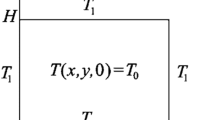Abstract
Nuclear materials are highly complex multiscale, multiphysics systems, and an effective prediction of nuclear reactor performance and safety requires simulation capabilities that tightly couple different physical phenomena. The Idaho National Laboratory’s Multiphysics Object Oriented Simulation Environment (MOOSE) provides the computational foundation for performing such simulations and currently consists of the continuum scale fuel performance code Bison and the mesoscale phase-field code Marmot. With the move towards advanced reactors that employ high temperature fluids compared to conventional reactors, corrosion has become a problem of great interest. A new application called Yellowjacket is under development to directly couple thermodynamic equilibrium and kinetics with phase field models in order to model corrosion in advanced reactors. As part of Yellowjacket, a thermochemistry code is being developed to perform thermochemical equilibrium calculations for a range of different materials, which is currently in its infancy. This paper describes the recent progress towards the development of Yellowjacket and presents the plans for develo** capabilities of practical interest to the nuclear industry.
Access this chapter
Tax calculation will be finalised at checkout
Purchases are for personal use only
Similar content being viewed by others
Notes
- 1.
From a computational perspective, the method of Lagrange multipliers used to compute thermochemical equilibrium results in an objective function where the linear combinations of Lagrange multipliers give the chemical potential of elements. Furthermore, the dimensionless form of chemical potentials helps reduce the computational costs.
- 2.
Though the Gibbs energy profile shown in Fig. 4 is continuous, the actual results on the finite element mesh are discretised due to a step change in the temperature as we move from one element to the other. The continuous profile has been plotted by interpolation during post-processing and is a better representation of the physical conditions where we expect no step changes if a temperature gradient is applied.
References
Stan M (2009) Discovery and design of nuclear fuels. Mater Today 12(11):20– https://doi.org/10.1016/S1369-7021(09)70295-0
Devanathan R, Van Brutzel L, Chartier A, Guéneau C, Mattsson AE, Tikare V, Bartel T, Besmann T, Stan M, Van Uffelen P (2010) Modeling and simulation of nuclear fuel materials. Energy Environ Sci 3(10):1406–1426. https://doi.org/10.1039/C0EE00028K
Gaston DR, Permann CJ, Peterson JW, Slaughter AE, Andrš D, Wang Y, Short MP, Perez DM, Tonks MR, Ortensi J, Zou L, Martineau RC (2015) Physics-based multiscale coupling for full core nuclear reactor simulation. Ann Nucl Energy 84:45–54
Alger B, Andrš D, Carlsen RW, Gaston DR, Kong F, Lindsay AD, Miller JM, Permann CJ, Peterson JW, Slaughter AE, Stogner R (2019) MOOSE Web page. https://mooseframework.org
Pelton AD, Degterov SA, Eriksson G, Robelin C, Dessureault Y (2000) The modified quasichemical model i – binary solutions. Metall Mater Trans B 31B:651–659
Pelton AD, Chartrand P (2001) The modified quasichemical model ii – multicomponent solutions. Metall Mater Trans A 32A:1355–1360
Chartrand P, Pelton AD (2001) The modified quasichemical model iii – two sublattices. Metall Mater Trans A 32:1397–1407
Pelton AD, Chartrand P, Eriksson G (2001) The modified quasichemical model iv – two-sublattice quadruplet approximation. Metall Mater Trans A 32:1409–1416
Lambotte G, Chartrand P (2011) Thermodynamic optimization of the (\(Na_{2}O + SiO_{2} + NaF + SiF_{4}\)) reciprocal system using the modified quasichemical model in the quadruplet approximation. J Chem Thermodyn 43(11):1678–1699. https://doi.org/10.1016/j.jct.2011.05.038
Hillert M (2001) The compound energy formalism. J Alloys Compd 320(2):161–176
Hillert M (1981) Some viewpoints on the use of a computer for calculating phase diagrams. Physica B+C 103(1):31–40. https://doi.org/10.1016/0378-4363(81)91000-7
Piro MHA, Besmann TM, Simunovic S, Lewis BJ, Thompson WT (2011) Numerical verification of equilibrium thermodynamic computations in nuclear fuel performance codes. J Nucl Mater 414(3):399–407. https://doi.org/10.1016/j.jnucmat.2011.05.012
Piro MHA, Simunovic S (2016) Global optimization algorithms to compute thermodynamic equilibria in large complex systems with performance considerations Comput Mater Sci 118:87–96
Liu ZK, Wang Y (2016) Computational thermodynamics of materials. Cambridge University Press, Cambridge
Bale CW, Belisle E, Chartrand P, Decterov S, Eriksson G, Gheribi AE, Hack K, Jung I-H, Kang Y-B, Melancon J, Pelton AD, Petersen S, Robelin C, Sangster J, Spencer P, Ende M-AV (2016) FactSage thermochemical software and databases, 2010–2016. Calphad 54(0364–5916):35–53. https://doi.org/10.1016/j.calphad.2016.05.002
Eriksson G, Thompson WT (1989) A procedure to estimate equilibrium concentrations in multicomponent systems amd related applications. Calphad 13(4):389–400. https://doi.org/10.1016/0364-5916(89)90027-8
Poschmann M, Piro MHA, Simunovic S (2019) Acceleration of thermochimica calculations in Bison. Oak Ridge National Laboratory (in review)
Piro MHA (2017) Updating the estimated assemblage of stable phases in a Gibbs energy minimizer. Calphad 58:115–121
White WB, Johnson SM, Dantzig GB (1958) Chemical equilibrium in complex mixtures. J Chem Phys 28(5):751–755. https://doi.org/10.1063/1.1744264
Piro MHA (2011) Computation of thermodynamic equilibria pertinent to nuclear materials in multi-physics codes. Royal Military College of Canada
Piro MHA, Poschmann M, Bajpai P (2019) On the interpretation of chemical potentials computed from equilibrium thermodynamic codes: applications to molten salts. J Nucl Mater 526(0022–3115):151756. https://doi.org/10.1016/j.jnucmat.2019.151756
Beneš O, Konings RJM (2012) Molten salt reactor fuel and coolant. In: Konings RJ (ed) Comprehensive nuclear materials. Elsevier, Oxford, pp 359 – 389. https://doi.org/10.1016/B978-0-08-056033-5.00062-8
Ocadiz-Flores JA, Capelli E, Raison PE, Konings RJM, Smith AL (2018) Thermodynamic assessment of the \(LiF-NiF2\), \(NaF-NiF2\) and \(KF-NiF2\) systems. J Chem Thermodyn 121:17–26. https://doi.org/10.1016/j.jct.2018.01.023
Author information
Authors and Affiliations
Corresponding author
Editor information
Editors and Affiliations
Rights and permissions
Copyright information
© 2020 The Minerals, Metals & Materials Society
About this paper
Cite this paper
Bajpai, P., Poschmann, M., Andrš, D., Bhave, C., Tonks, M., Piro, M. (2020). Development of a New Thermochemistry Solver for Multiphysics Simulations of Nuclear Materials. In: TMS 2020 149th Annual Meeting & Exhibition Supplemental Proceedings. The Minerals, Metals & Materials Series. Springer, Cham. https://doi.org/10.1007/978-3-030-36296-6_95
Download citation
DOI: https://doi.org/10.1007/978-3-030-36296-6_95
Published:
Publisher Name: Springer, Cham
Print ISBN: 978-3-030-36295-9
Online ISBN: 978-3-030-36296-6
eBook Packages: Chemistry and Materials ScienceChemistry and Material Science (R0)




